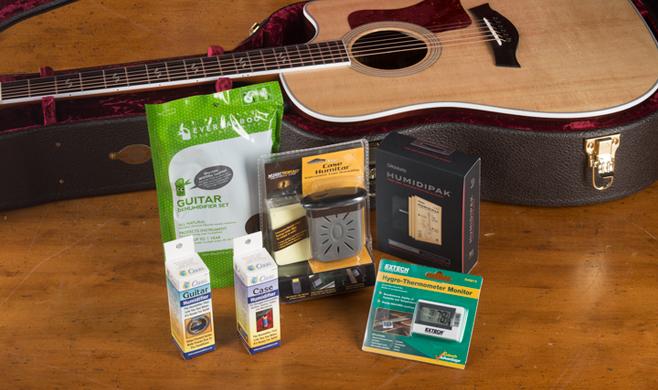Guitars are like Goldilocks – they need everything to be just right in order to thrive. And one of the key factors in ensuring your guitar stays in tip-top shape is maintaining optimal humidity levels. No, we’re not talking about turning your practice space into a rainforest sauna. We’re talking about finding that sweet spot where your guitar can live its best life without turning into a shriveled up, sad excuse for an instrument. So grab a cup of tea, cozy up, and let’s talk about how to keep your guitar happy and healthy by controlling the humidity.
Contents
- 1 Understanding the Impact of Humidity on Your Guitar
- 2 Identifying the Ideal Humidity Range for Guitar Storage
- 3 Effective Strategies for Monitoring Humidity Levels
- 4 Implementing Humidification Solutions to Protect Your Instrument
- 5 Dehumidification Techniques for High Humidity Environments
- 6 Regular Maintenance Tips for Preserving Guitar Condition
- 7 Troubleshooting Common Humidity-Related Issues with Guitars
- 8 FAQs
- 9 Strumming Along with the Right Humidity
Understanding the Impact of Humidity on Your Guitar
So you think you’ve mastered the art of guitar playing, huh? Well, think again my friend, because there’s one sneaky little factor that can wreak havoc on your precious instrument – humidity!
Let’s break it down, shall we? Here’s how humidity can make your guitar go from sounding like a heavenly melody to a screeching banshee:
- Swollen Wood: When humidity levels are too high, the wood on your guitar can swell up like a pufferfish who just discovered an all-you-can-eat buffet. This can cause all sorts of issues like buzzing strings and wonky frets.
- Cracked Finish: On the flip side, if the humidity drops too low, the finish on your guitar can crack and peel faster than a sunburnt tourist in Cancun. Say goodbye to that shiny, pristine look you once loved!
- Wonky Tuning: Humidity changes can also mess with the tension on your strings, causing your guitar to go out of tune faster than a toddler playing with a tuning peg. One minute you’re rockin’ out to your favorite tune, the next you sound like a cat being strangled.
So, what’s a guitar aficionado to do? Fear not, my fretting friend! There are ways to combat the evil clutches of humidity. Invest in a humidifier or dehumidifier to keep your guitar in check, and always store it in a climate-controlled environment. Trust me, your guitar will thank you!
Identifying the Ideal Humidity Range for Guitar Storage
So, you’ve finally decided to give your guitar the storage space it deserves. But before you toss it in any old closet and call it a day, let’s talk humidity.
**Humidity is the silent killer of guitars**, much like that one awkward uncle at family gatherings. Too much moisture can cause wood to swell and warp, while too little can lead to cracking and a general lack of mojo. But fear not! We’re here to guide you through the treacherous waters of humidity control.
First things first, **the ideal humidity range for guitar storage is between 45% and 55%**. This sweet spot will keep your instrument happy and healthy, much like a steady diet of pizza and Netflix. Invest in a good quality hygrometer to keep track of the humidity levels in your storage space. And remember, consistency is key – aim for stability like that one friend who never cancels plans.
Now, you may be wondering how to achieve this magical humidity range. Fear not, dear reader, for we have a few tricks up our sleeves. Consider investing in a humidifier or dehumidifier, depending on your specific needs. And don’t forget to keep your guitar in a hard case when not in use – it’s like a cozy little fortress against the humidity monsters.

Effective Strategies for Monitoring Humidity Levels
When it comes to keeping humidity levels in check, it’s important to have effective strategies in place. Here are some creative ways to ensure your humidity levels stay just right:
- Invest in a good quality hygrometer to accurately measure the humidity levels in your space.
- Use a dehumidifier to remove excess moisture from the air, especially in areas prone to high humidity.
- Open windows and doors to let fresh air in and allow for proper air circulation.
Another fun way to monitor humidity levels is by observing your houseplants. If your plants are wilting or leaves are turning brown, it could be a sign that the humidity levels are too low. On the other hand, if your plants are developing mold or fungus, it may be a sign that humidity levels are too high.
Remember, finding the perfect balance of humidity levels is key to creating a comfortable and healthy living environment. So don’t sweat it - with these creative strategies, you’ll be able to monitor and adjust humidity levels with ease!

Implementing Humidification Solutions to Protect Your Instrument
So, you’ve invested in a top-of-the-line instrument and now you want to make sure it stays in tip-top shape. Well, fear not my fellow musician, because implementing humidification solutions is the key to keeping your instrument safe from the dreaded effects of dry air!
First things first, let’s talk about why humidification is so important. Dry air can wreak havoc on wood instruments, causing them to crack, warp, and lose their tone. But fear not, for there are solutions to combat this villainous foe!
One of the easiest ways to protect your instrument is by using a humidifier. Simply place a humidifier in the room where you keep your instrument and watch as it works its magic to keep the air at the optimal humidity level. Your instrument will thank you for it!
Another great option is a case humidifier. These nifty little devices fit right into your instrument case and work to maintain the perfect humidity level wherever you go. So whether you’re jamming out at home or hitting the road for a gig, your instrument will stay safe and sound.

Dehumidification Techniques for High Humidity Environments
Living in a high humidity environment can feel like swimming through a sea of moisture every day. But fear not, there are dehumidification techniques that can help you dry out and breathe a little easier. Here are some creative ways to combat the damp:
- Invest in a dehumidifier – this handy contraption sucks up moisture like a thirsty sponge. Just plug it in and let it work its magic.
- Open the windows and let the fresh air in – sometimes all your home needs is a little air circulation to push out the pesky humidity.
- Get some houseplants – not only do they add a touch of green to your space, but they also help absorb excess moisture in the air.
Another fun technique to try is creating your own DIY dehumidification system. All you need is some rock salt and a few bowls. Fill the bowls with rock salt and place them strategically around your home. The salt will naturally absorb the moisture in the air, leaving you with a drier, more comfortable living space.
So don’t let high humidity get you down. With a little creativity and some simple techniques, you can banish the moisture and reclaim your space. Say goodbye to that soggy feeling and hello to a fresh, dry environment!
Regular Maintenance Tips for Preserving Guitar Condition
It’s important to take care of your guitar to keep it looking and sounding its best. Here are some maintenance tips to help preserve your instrument:
- **Clean your guitar regularly:** Dust and grime can build up on your guitar, affecting its appearance and playability. Use a soft cloth to wipe down the body, neck, and strings after each use.
- **Keep it hydrated:** Just like you, your guitar needs to stay hydrated. Use a humidifier to maintain the proper moisture levels in the air to prevent the wood from drying out and cracking.
**Watch out for temperature changes:** Extreme temperatures can warp your guitar’s body and neck. Avoid leaving your guitar in a hot car or cold basement for extended periods of time.
- **Get regular tune-ups:** Just like a car, your guitar needs regular maintenance. Take it to a professional luthier for a tune-up every year or so to keep it playing like new.
Troubleshooting Common Humidity-Related Issues with Guitars
If you find your guitar is sounding a little off-key lately, it might be due to humidity-related issues. Here are some common problems and how to troubleshoot them:
- String Buzz: If your guitar strings are buzzing more than a busy beehive, it could be due to low humidity levels. Try using a humidifier to add moisture to the air and keep your guitar happy and buzz-free.
- Fretboard Cracks: If you notice cracks or warping on your fretboard, high humidity levels may be the culprit. Store your guitar in a dry environment or use a dehumidifier to prevent further damage.
- Tuning Instability: Is your guitar constantly going out of tune, despite your best efforts? Fluctuating humidity levels can wreak havoc on tuning stability. Consider investing in a guitar case with a built-in humidity control system to keep your instrument in tune.
Remember, a little care and attention goes a long way when it comes to humidity-related issues with guitars. Keep your instrument happy and healthy by monitoring humidity levels and taking preventative measures to avoid common problems. Your guitar will thank you with beautiful melodies and smooth playability!
FAQs
Why is it important to maintain a consistent humidity level for your guitar?
Well, have you ever seen a dried-up prune? That’s basically what happens to your guitar if it’s exposed to fluctuations in humidity. You don’t want your prized possession turning into a raisin, do you?
What happens when your guitar is exposed to too much humidity?
Imagine your guitar sitting in a sauna all day long. It might start to swell up like a pufferfish, causing all sorts of issues with the wood and the overall playability. Plus, no one wants a sweaty guitar!
Can a lack of humidity be damaging to your guitar?
Just like a desert cactus, your guitar can dry out and crack if it’s not given enough moisture. It’s like trying to play a bunch of sad, out-of-tune notes on a parched instrument.
What are some signs that your guitar is being affected by humidity levels?
If your guitar starts buzzing more than a beehive, or if you notice any weird warping or cracking in the wood, chances are humidity is the culprit. Don’t ignore the warning signs!
How can you maintain optimal humidity levels for your guitar?
Invest in a good quality guitar humidifier, or even a humidity control system for the room where you keep your guitar. It’s like giving your guitar a nice, relaxing spa day to keep it happy and healthy.
Strumming Along with the Right Humidity
Well, congratulations on making it to the end of this article! You are now armed with the knowledge you need to keep your beloved guitar in tip-top shape by maintaining optimal humidity levels. Remember, a happy guitar is a happy musician!
So go forth, strum away, and may your chords always be in tune. And hey, if all else fails, you can always blame the weather for any off-key moments. Happy playing!



